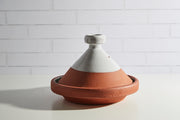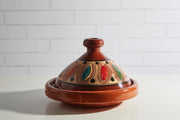Situated on Africa’s northwestern-most point, Morocco is a land steeped in tradition and rich with a confluence of Berber, Arabian, and European cultural influences. There, artisans take pride in their craft–often honing their skill from childhood as part of the family trade. At Verve Culture, we’re honored to work with some of the country’s most talented individuals. Let us introduce you.
Meet ceramics-maker Hussein Akid

Born into a family of ceramic artists, Hussein has been involved in the family craft since he was just five years old. His contemporary tagines use red clay collected near his home in Ourika, a small village just under 30 miles from the major city of Marrakesh. Each tagine is a labor of love: “First, we do a bisque fire for 9 hours. Then cooling. Then we do a glaze fire for 10 hours. Then cooling for 8 hours,” he explains. “I love my work.”
Meet basket-maker Abdelkabir Fessaoui

For Abdelkabir, basket-making is a family affair. Together with his brothers, he
crafts custom leather handles and chic accents for baskets made from palms sourced in Taza, a city in northern Morocco, and Marrakesh, a former imperial city in western Morocco. Though Abdelkabir also sells his traditional wares in local markets, he creates special designs for Verve Culture’s subtly stylish Shopping Basket and Shopping Basket Backpack.
Meet tagine-maker Abdullah Chagouri

Abdullah is an expert at creating functional art with clay. After all, the Ministries of Artisan Craft-certified maker has been honing his art for more than 40 years. “Certain potters have a ‘touch’ and can be identified by their special design,” he explains. “I love to play with clay and experiment with shapes, but [I] mainly make traditional shapes of platters and tagines.”
Meet ceramics-makers Salah, Halima, and Hamina

When Salah was 8 years old, her uncle began teaching her the magic of shaping and painting pottery. She listened closely, learning what she describes as “the secrets” of manufacturing. Today, she works alongside other family members, including her twin cousins Halima and Hamina, to showcase the beauty of Safi culture in handcrafted pieces like these Blue Moroccan Serving Dishes and Nesting Moroccan Soup Set.
Meet instrument-maker Mohammed Laagaje

Attend a music festival in Morocco, and it’s possible you’ll hear someone drumming, strumming, or chiming along on one of Mohhammed’s handcrafted instruments. Specializing in Derbouka (drums), Gimbri (three-string guitars), “RIQ” (tambourines), and Qarqaba (hand castanets), he says, “It gives us pleasure to know that musicians seek out our instruments.”
Meet slipper-maker Moulay Hassan

Moulay appreciates the challenge of his life’s work crafting bags, belts, babouche, and items from leather and kilim rugs. “I can make anything using the traditional leather and kilim fabrics because I've been working them my entire life,” he says, noting quality is always his top priority. Among his specialties, however, are his traditional, open-back, "Babouche" slippers, available in colorful leather varieties and one-of-a-kind Kilim rug remnants.
Meet leather goods-maker Youssef Elrhoddani

For Youssef, leather is a canvas. He buys cured goat, sheep, cow, and camel hides and adds natural dye to complement the original coloring. Then, he and his team add zippers, trim, and other thoughtful details to create products like these elegant poufs. “I make the patterns for new styles, but I have a lot of tried-and-true patterns handed down to me from my grandfather,” he says.
Meet Berber silver-maker Hammouda Elbouhi

In Morocco, it’s tradition to serve mint tea as a welcoming gesture for visiting family and guests. Using only handmade techniques, Hammouda crafts items like the Moroccan Berber Silver Coasters that facilitate this centuries-old custom. “The tea is a ceremony, and the tea is poured from a great height to show skill and honor,” he says, adding, “Any opportunity to share our culture … is an honor.”











